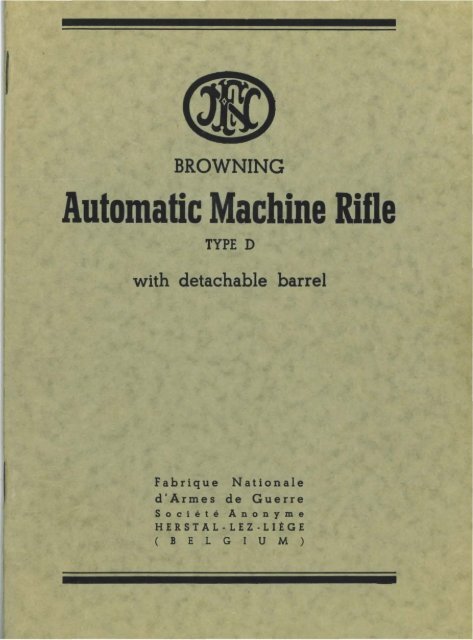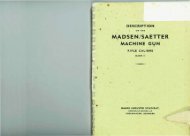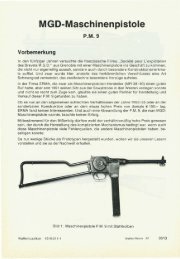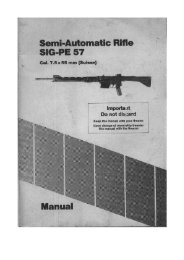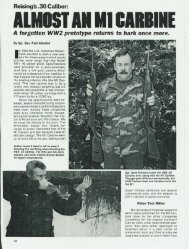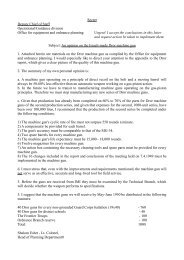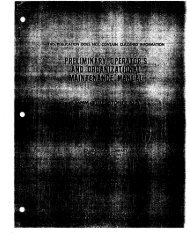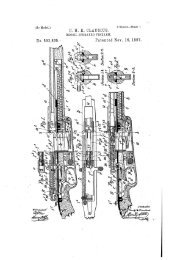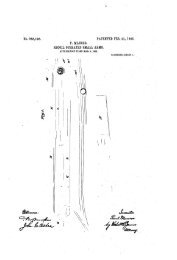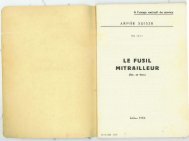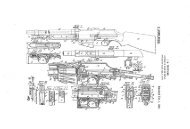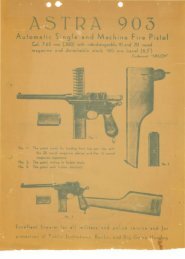Browning Automatic Machine Rifle Type D manual.pdf - Forgotten ...
Browning Automatic Machine Rifle Type D manual.pdf - Forgotten ...
Browning Automatic Machine Rifle Type D manual.pdf - Forgotten ...
Create successful ePaper yourself
Turn your PDF publications into a flip-book with our unique Google optimized e-Paper software.
I<br />
BROWNING<br />
<strong>Automatic</strong> <strong>Machine</strong> <strong>Rifle</strong><br />
TYPE D<br />
with detachable barrel<br />
Fabrique Nationale<br />
d'Armes de Guerre<br />
Societe Anonyme<br />
HERSTAL-LEZ-LIEGE<br />
(BELGIUM)
BROWNING<br />
<strong>Automatic</strong> <strong>Machine</strong> <strong>Rifle</strong><br />
TYPE D<br />
with detachable barrel<br />
Fabrique Nationale<br />
d'Armes de Guerre<br />
Societe Anonyme<br />
HERSTAL-LEZ-LIEG£<br />
( BELGIUM )<br />
---®---
INTRODUCTION<br />
The <strong>Browning</strong> automatic rifle was originally designed<br />
by John <strong>Browning</strong> in 1917, to meet the requirements of the<br />
American Army during the 1914-1918 war. For this purpose<br />
it was mass-produced by the Colt Company in America,<br />
and used by the U. S. Armed Forces during the first world<br />
war and also in the second.<br />
John M. <strong>Browning</strong> had for several years worked in<br />
Liege in close collaboration with Fabrique Nationale<br />
d'Armes de Guerre, and during this time had perfected<br />
many inventions. It was, therefore, natural that the<br />
<strong>Browning</strong> automatic machine rifle patents should be<br />
entrusted to them for manufacture.<br />
During the period between the two wars F. N. introduced<br />
several modifications and improvements. These<br />
culminated in the ·· <strong>Type</strong> 3o ··, made to the requirements<br />
of the Belgian Government, and incorporated a gas regulator<br />
and a slowing-up device to be used to reduce the<br />
rate of fire, when required.<br />
Fabrique N ationale have now put on the market the<br />
present Model ·' D '·, which embodies the experience gained<br />
during the last war, and the technical advantages of<br />
modern steels and methods of production. The main<br />
features of the original design are still maintained, but in<br />
the new model the barrel has been made removable, and<br />
it is possible to take out the breech-block mechanism<br />
without complete stripping.<br />
---®---3
6<br />
--®--<br />
Qi<br />
....<br />
....<br />
...Q "'<br />
GENERAL CHARACTERISTICS<br />
Method of operation. - The breech mechanism is automatically<br />
opened by means of gas operating through<br />
the gas cylinder on a piston. The closing of the<br />
breech is done by means of the usual return springs.<br />
During the actual firing of the cartridge the breechblock<br />
is positively locked, but remains held in the<br />
rear position after the opening operation has been<br />
performed.<br />
Detachable barrel. - This is held in the receiver by a<br />
differential nut, which takes up any play or clearance<br />
between the barrel and receiver. The barrel is aircooled<br />
by flanges, and is equipped with a handle<br />
for transport or dismounting of the barrel.<br />
Method of feed. - The method of feed is by means of a<br />
20-round magazine positioned in the underside of<br />
the receiver. This position reduces visibility to an<br />
enemy, and magazines can be changed without the<br />
firer betraying his position.<br />
Rates of fire. - The normal rate of fire is 600 rounds per<br />
minute, but a specially designed slowing-up device,<br />
which is incorporated in the trigger guard, enables<br />
this rate to be reduced to 350 rounds per minute.<br />
Stripping. - Stripp-ing. is possible in two. stages. In the<br />
first place the breech-block can be quickly removed<br />
by the firer, whilst still in the firing position, for the<br />
purpose of replacing a firing pin or extractor.<br />
Complete stripping of the mechanism can be done<br />
in the same position by hinging the butt downwards<br />
to form a support, leaving both hands free to handle<br />
the mechanism.<br />
Safety. - Every care has been taken to ensure safety under<br />
all conditions. In addition to the normal mechanical<br />
safeties, the breech-block is also positively locked at<br />
the moment of firing, which cannot occur prematurely.<br />
The mechanism being held in the rear position<br />
---®---7
after a round has been fired enables the chamber to<br />
cool more quickly, and there is no danger from a<br />
cartridge being left in a hot barrel.<br />
Suppleness. - The <strong>Browning</strong> automatic rifle has a remarkable<br />
suppleness of action because the opening<br />
of the bolt is progressive by means of cams. The<br />
extraction of the case does not occur by a straight<br />
pull but by soft primary extraction. This avoids<br />
hardship of the mechanism and allows a good<br />
functioning without cleaning nor oiling event with<br />
ammunition which are not perfect. It is one of<br />
the reasons why the gun is able to function without<br />
breakages or stoppages of
96 Return springs tube screw.<br />
97E External return spring.<br />
971 Internal return spring.<br />
98 Return springs cap.<br />
.100 Buffer friction ring.<br />
101 Buffer friction cone.<br />
102 Buffer plug.<br />
103 Buffer spring.<br />
104 Buffer tube nut.<br />
106 Butt plate screw (short).<br />
107 Butt plate screw (long).<br />
109 Butt support screw.<br />
263 Butt plate.<br />
264 Shoulder strap.<br />
265 Shoulder strap ax1s pm.<br />
266 Shoulder strap spnng.<br />
267 Shoulder strap spring screw.<br />
268 Butt support.<br />
269 Butt support socket catch.<br />
270 Butt support socket catch axis pm.<br />
271 Butt support socket catch spring.<br />
272 Butt support socket ring.<br />
274 Sling swivel.<br />
The butt (93) in walnut, has a butt plate (263) with<br />
a swinging shoulder strap (264) which makes it easier to<br />
aim the gun.<br />
The butt is fastened to its support (8h) by a screw (94) .<br />
The butt plate is fastened by screws to the butt ( 106,<br />
107) and to the butt support (94).<br />
The bushing (268) is fastened on the lower part of the<br />
butt by screws (109). (This device makes it possible to<br />
fasten the gun to a light tripod.)<br />
24---®---<br />
..<br />
At the front end of the butt the support (8h) contains<br />
the buffer consisting of a plug (102), four friction rings (100),<br />
four cones (101) and the buffer spring (103) .<br />
A tube (95) is screwed at the end of the support by a<br />
ring (104). The tube (95) contains the recoil springs (97E,<br />
971) with their cap (98) and screw (96).<br />
--®-- 25
6. MAGAZINE<br />
131 127 132<br />
Plate IX.<br />
List of component parts<br />
127 Magazine.<br />
130 Magazine bottom plate.<br />
131 Magazine platform.<br />
132 Magazine platform spring.<br />
The magazine contains 20 cartridges. It 1s made of<br />
steel sheet reinforced by stamped grooves.<br />
The upper face is open. The cartridges slide out along<br />
the lips of the upper opening of the magazine.<br />
The magazine platform (131) pushes upward the cartridges<br />
through the action of the spring {132) which leans<br />
against the bottom plate {130) of the magazine.<br />
The platform has at the rear a tail which acts the slide<br />
stop {238) when the magazine is empty.<br />
26- - -®---<br />
130<br />
7. ACCESSORIES<br />
Plate X.<br />
List of component parts<br />
133 Flash hider.<br />
501 Combination tool.<br />
502 Magazine filler.<br />
503 Blank firing device.<br />
504 Gas cylinder cleaning tool.<br />
505 Cleaning rod {3 pieces).<br />
506 Barrel cleaning jag.<br />
507 Barrel cleaning brush.<br />
508 Chamber cleaning brush.<br />
509 Extractor for ruptured cases.<br />
510 Oil can, petrol can.<br />
511 Fabric accessory case.<br />
513 Belt for magazines.<br />
515 Fabric pocket for small pieces.<br />
516 Strap.<br />
518 Fabric and leather case for spare barrel.<br />
---®--- 27
FUNCTIONING<br />
FORWARD MOVEMENT<br />
The gun being cocked 1 when the trigger (210) is pulled 1<br />
the slide (205) is released by the right sear (213) and the<br />
mechanism is pushed forward by the recoil springs (97E 1<br />
971) . The bottom of the bolt (40) strikes the upper part<br />
of the first cartridge and pushes it into the chamber. The<br />
base of the cartridge case slides up the front face of the<br />
bolt (40) behind the extractor (45). When the lower cam<br />
surface of the breech-block (41) strikes the end of the bolt<br />
supports (11 1 12) the breech-block ro.i:;as up. Th e bolt (40)<br />
stops against the rear face of the barrel. The breech-block<br />
(41) pushed upward through the link (43) by the slide (205) 1<br />
which moves forward 1 comes in the locking recess of the<br />
receiver (8). The breech-block leaning against the locking<br />
face of the receiver completely locks the gun. The slide<br />
(205) continues forward with the hammer (48) which strikes<br />
the firing pin (47) and fires the primer of the cartridge.<br />
The forward movement of the slide is stopped when its<br />
shoulder strikes the rear part of the gas cylinder (247).<br />
BACKWARD MOVEMENT<br />
After the shot has been fired 1 when the bullet passes<br />
the gas opening in the barrel 1 a part of the expanding<br />
powder gases passes through the opening into the gas<br />
cylinder (247) and pushes to the rear the piston (204) and<br />
the slide (205). The slide (205L through the link (43) pulls<br />
down the breech-block (41) and unlocks the gun. The<br />
bolt (40) starts very slowly backwards/ gaining speed as<br />
the breech-block (41) nears its completely unlocked position.<br />
When this point is reached the bolt (40) and breechblock<br />
(41) travel at the same speed as the slide (205). The<br />
withdrawal of the firing pin (47) results from the action<br />
of the slope cut in the breech-block (41) on the firing pin<br />
heel. The empty case is drawn from the chamber by the<br />
extractor (45) and is held against the front face of the bolt<br />
(40) until it strikes the ejector (241) which throws it out to<br />
the right through the ejection opening.<br />
28---®---<br />
The backward movement limited to the rear by the<br />
buffer (102) produces the compression of the return springs<br />
(97E 1 971) . The opening movement being complete 1 the<br />
slide (205) and the whole firing mechanism is held to the<br />
rear as the slide (205) is hooked by the right sear (213).<br />
A remarkable feature of the <strong>Browning</strong> automatic rifle<br />
is the extreme softness with which the case is drawn out<br />
of the chamber. At the beginning of the opening movement<br />
when the breech-block reaches its low position1 it<br />
is slightly pushed backward by a progressive movement<br />
when its cam comes in contact with the rear parts of the<br />
bolt guides (11 1 12). That slight movement to the rear<br />
loosens the case from the chamber before it is carried out<br />
by direct pull. Extraction occurs thus by a double movement:<br />
first loosen the case from tl;le chamber1 then pull<br />
out by direct pull. That is one of the reasons why the<br />
gun is able to function correctly even with irregular<br />
ammunition.<br />
AUTOMATIC FIRING AT FULL RATE<br />
Cock the gun and set change lever (219) in position<br />
'" M ''. Pull the trigger. Firing will be going on at full<br />
rate until the pull on the trigger is released. With change<br />
lever (219) in the ·· M '' position. the left sear (216) is switched<br />
off and does not interfere with the movement of the slide<br />
(205) . The slowing-up device has consequently no action<br />
on the mechanism.<br />
AUTOMATIC FIRING AT SLOW RATE<br />
Cock the gun and set change lever (219) in position<br />
·· R ·· . The slide is kept in the rear position by the right<br />
sear (213) which is a little longer than the left sear (216).<br />
By pulling the trigger (210) the sear (213) releases the slide<br />
(205). The slide (205) pushed forward by the recoil springs<br />
(97E. 971) is retained by the second sear (216) which moves<br />
slightly forward owing the oval hole of its pin (57) . The<br />
left sear drives forward the catch (220) which releases the<br />
slowing-up device lever (227). This lever raises up under<br />
the action of the spring (223). The raising movemertt of<br />
the lever is slowed by the interference of the rack (230L<br />
--®--29
the pinion (231) and the ratchet (233). That slowing-up<br />
movement constitutes the slowing-up of the rate of fire<br />
itself.<br />
The lever (227) being raised, swings up the forward<br />
end of the left sear (216) and draws down the rear end of<br />
the sear. When the raising movement of the lever (227)<br />
is completed, the sear (216) disengages completely from<br />
the notch in the slide and the slide is released and pushed<br />
forward by the return springs (97£, 971) . When moving<br />
forward the slide (205) depresses the lever (227) which is<br />
caught again by the latch (220).<br />
SINGLE SHOT FIRING<br />
Cock the gun and set change lever (219) in pos1t10n<br />
·· R ·· (same as for slow automatic firing). Release the<br />
trigger after each shot. The rate of fire is slow enough to<br />
release the trigger quickly enough to prevent double shots.<br />
GAS INLET ADJUSTMENT<br />
The gun being ready in firing position, the adjustment<br />
of the gas inlet is made as follows:<br />
Unscrew the shroud {255) by means of the screw (253)<br />
and the combined tool (501) until the gas escape holes are<br />
nearly discovered. Cock the gun and set change lever<br />
{219) in position ··R ·· . Firing shot by shot the mechanism<br />
must remain open after every shot, the slide being stopped<br />
at the rear, and the ejection must be normal, i.e. the empty<br />
cases are projected about one and a half yard away.<br />
If the functioning is not correct screw the mantle a<br />
little more, in order to obturate a little more the gas escape<br />
holes, until functioning is correct.<br />
If the ejection is too violent unscrew the shroud until<br />
functioning is as described above.<br />
FUNCTIONING OF THE BUFFER<br />
After every shot, the slide (205) is violently projected<br />
to the rear. That movement is slowed by the return springs<br />
(97E, 971) through the return spring rod (50).<br />
30---®---<br />
The slide strikes the plug (102) which recoils and<br />
pushes back the first friction ring ( 100) and the first cone<br />
(101) which is pressed into the ring and pushes the next<br />
one and so on the last one compressing the buffer spring<br />
(103). The friction rings (100) who are split, open slightly<br />
under action of the cones (101) and rub against the tube<br />
(8h) containing the buffer. The friction of the rings ( 100)<br />
added to the action of the return springs (97£, 971) and<br />
that of the buffer spring ( 103) absorb the recoil of the<br />
mechanism.<br />
- ---®--- 31
HOW TO OPERATE THE GUN<br />
TO PUT THE GUN IN FIRING POSITION<br />
Squeeze slightly the two legs of the bipod (290) and<br />
swing· them to the front until they are perpendicular to<br />
the gun. Release the legs which will open under action<br />
of their spring (121R) . The tops of the legs will insert<br />
themselves in the grooves of the head of the bipod (112).<br />
The bipod is then in position to support the gun. Swing<br />
the handle (1d) to the left and engage end of the handle<br />
in the groove of the nut (1b). Open magazine cover (88)<br />
by swinging it fo rward. Open ejecti:::;• t opt.ning cover (16}.<br />
Raise shoulder plate (265}.<br />
TO REMOVE THE GUN FROM FIRING POSITION<br />
Lower the shoulder plate (265}.<br />
Close ejection open'ing cover (16). Close magazine<br />
cover (88) . Disengage the handle (1d) out of the nut (1b)<br />
and swing it upward. Squeeze the legs of the bipod (290)<br />
in order to disengage their heads from the grooves in the<br />
bipod head (112} and swing them backward along the gas<br />
cylinder.<br />
TO PUT THE GUN IN SAFETY<br />
Push the change lever (219} in front of the letter " S".<br />
In that position the trigger (210) is locked and unable to<br />
act on the sear (213).<br />
TO LOAD THE GUN<br />
Pull back the cockinq lever (33} as far as possible to<br />
the rear in order to let the slide (205} be caught by the<br />
sear (213) . Push forward cocking lever (33} . Push a filled<br />
magazine upward in the receiver.<br />
Push the change lever (219) in the desired position<br />
{full or slow rate of fire). The gun is ready to fire.<br />
32---®---<br />
TO UNLOAD ·THE GUN<br />
Drop the magazine by pulling the magazine catch<br />
(244}. Close the mechanism by pulling the trigger. Push<br />
lever (219} in safety position ·· S ··.<br />
TO REMOVE THE BARREL<br />
Make sure that the end of the handle (1a) is inserted<br />
in the groove of the locking nut (1b). Press the locking<br />
lever (8a) and turn the handle (1d) upward to the vertical<br />
position. Take off the barrel by pushing forward on the<br />
handle.<br />
TO REPLACE THE BARREL<br />
Take the barrel by the handle (1d) the regulator being<br />
downward. Introduce the rear of the barrel in the receiver<br />
(8) the front of the barrel leaning in its V support in the<br />
front part of the gas cylinder (247} on its flat face. The<br />
regulator is then introduced in the gas cylinder (247}. Pull<br />
the barrel to the end in the receiver (8) and swing to the<br />
left as far as possible the handle (1d). The barrel is locked<br />
to the receiver.<br />
--®-- 33
DISMOUNTING AND ASSEMBLING<br />
A. DISMOUNTING AND ASSEMBLING<br />
OF THE MECHANISM<br />
I<br />
PARTIAL DISMOUNTING<br />
The rifle is left in the firing position, resting on its<br />
bipod.<br />
Remove the magazme (127) by pulling the magazine<br />
catch (244).<br />
Pull the trigger (210) to allow the mechanism to move<br />
forward.<br />
Remove the trigger guard retaining pin (52) and the<br />
trigger guard (207).<br />
With the left hand pull the cocking handle to the<br />
rear as far as possible; keep it in that position and press<br />
the right hand thumb on the bolt guide stud (14) which<br />
is placed on the receiver left side, above the cocking<br />
handle (33) .<br />
The bolt guide is withdrawn and the bolt (40) disengages<br />
itself under the action of its own weight.<br />
Let the mechanism move forward.<br />
The shooter can thus reach the bolt {40), the bolt lock<br />
{41), the extractor {45), the extractor spring (46) and the<br />
firing pin ( 47); the three latter parts can be replaced if<br />
necessary. This quick dismounting makes it also possible<br />
to have the trigger guard checked and dismounted if<br />
needed.<br />
PARTIAL ASSEMBLING<br />
Replace the firing pin {47), the extractor (45) and its<br />
spring (46) .<br />
With the left hand, pull the cocking handle (33) to<br />
the rear as far as possible.<br />
34 ---------® ----------<br />
With the right hand, grasp the bolt (40) and, while<br />
keeping the firing pin home {47), introduce the bolt {40}<br />
in the receiver (8) in order to engage the bolt head behind<br />
the bolt support (11 and 12).<br />
Press upwards in order to overcome the resistance of<br />
the bolt guide (14).<br />
Let the mechanism come forward under the action of<br />
the return springs {97I, 97E).<br />
Replace the trigger guard and its retaining pin (52).<br />
Replace the magazme.<br />
II<br />
COMPLETE DISMOUNTING<br />
The weapon is placed in the firing position on its<br />
bipod.<br />
Remove the magazine and let the mechanism come<br />
forward by pulling the trigger.<br />
Remove the trigger guard retaining pin (52) and the<br />
trigger guard {207) (for the dismounting of the trigger<br />
guard, see special chapter).<br />
Pull completely to the right the butt axis pin {8d)<br />
fixing the butt to the receiver.<br />
Swing completely downward the butt (93); the<br />
weapon is thus held standing by the bipod and the butt.<br />
By means of the recoil spring rod {50), pull to the<br />
rear the mechanism off the weapon, that is the slide {205),<br />
the piston (204), the bolt {40), the breech block (41), the<br />
link (43), the hammer (48) and the return spring rod (50) .<br />
Remove the firing pin (47) from the bolt (40).<br />
Remove the hammer pin {49). The slide is thus separated<br />
from the hammer (48) and from the link-bolt-breech<br />
block group.<br />
Withdraw the hammer {48) from the slide (205).<br />
---®--- 35
Remove the return spring rod (50).<br />
Remove the link pin (44) . The link (43) is thus separated<br />
from the bolt-breech-block group.<br />
Put the firing pin under the head of the extractor<br />
(45) and disengage the extractor from the bolt (40), remove<br />
the extractor (45) .<br />
Remove the extractor spring (46) .<br />
COMPLETE ASSEMBLING<br />
Replace the extractor spring (46) in the extractor (45) .<br />
Replace the extractor (45) in the bolt by pressing the<br />
head of the extractor and pushing it completely home.<br />
Reconnect the bolt-breech-block group to the link (43)<br />
by means of the link pin (44) .<br />
Replace the return spring rod (50) in the slide (205).<br />
Replace the hammer (4B) in the slide.<br />
Reconnect the bolt-link group to the slide (205) and<br />
to the hammer (4B) by means of the hammer pin (49) taking<br />
care to place the head of this pin on the right side of the<br />
slide.<br />
Replace the firing pin (47) in the bolt (40).<br />
Replace the parts constituting the mechanism in the<br />
receiver (B). Push home all the parts of the mechanism<br />
in the receiver by introducing the slide in its housing and<br />
keeping the bolt in the upper part of the receiver in such<br />
a way as to introduce it in its guiding grooves.<br />
Swing the butt (93) upwards.<br />
Fix the butt (93) to the receiver (B) by pushing home<br />
the axis pin (Bd).<br />
Replace the trigger guard (207) and its retaining pin<br />
(52).<br />
Replace the magazine (127).<br />
36---®---<br />
B. COMPLETE DISMOUNTING AND ASSEMBLING<br />
OF THE WEAPON<br />
I<br />
COMPLETE DISMOUNTING OF THE BARREL<br />
a) Remove the barrel of the weapon as indicated in<br />
the chapter ·' How to use the gun".<br />
b) Dismounting of the handle. - Unscrew the barrel<br />
ring (1b); to do so, disengage it from the handle support<br />
(1c), swing the handle until its nozzle is turned downwards<br />
and remove it. Unscrew the handle screw (Be), remove the<br />
washer (1e) and the handle (1d). The handle (1c) can then<br />
be disengaged from the main body of the handle liberating<br />
the spring (1f) and the handle spring head (1g) .<br />
c) Dismounting of the regulator. - Unscrew the<br />
regulator (252) by means of its nut (253) and remove the<br />
parts. Unscrew the regulator fixing screw (251) and<br />
remove the regulator (250) from behind.<br />
d) Unscrew the flash hider (133) or the muzzle nng<br />
(136).<br />
COMPLETE ASSEMBLING OF THE BARREL<br />
a) Assembling of the regulator. - Insert the regulator<br />
(250) in the gas cylinder tube bracket. Screw the<br />
regulator by means of the fixing screw (251) and screw<br />
the regulator nut (252) .<br />
b) Assembling of the carrying handle. - Replace<br />
the handle spring (1f) in the handle grip, fit the handle<br />
spring head (1g) on its spring (1e), insert the handle (lc)<br />
in the handle support (1a) and push it home in order to<br />
press the spring completely, then introduce the handle<br />
(ld) completely home. Replace the washer (le) and the<br />
nut (Be) .<br />
c) Replace the carrying handle on the barrel, proceeding<br />
by reverse way as when dismounting it.<br />
d) Replace the flash hider (133) or the muzzle ring (136) .<br />
--®-- 37
Remove the ejector (241) and the slide stop {238).<br />
Unscrew the hand grip screws (51d) and remove right<br />
and left hand grip plates {208, 209}.<br />
COMPLETE ASSEMBLING OF THE TRIGGER GUARD<br />
Replace the grip plates (208, 209} and fasten them with<br />
the screws (51d).<br />
Replace the ejector {241) and the slide stop (238) in<br />
their grooves (the upper one fo r the ejector) . Stop the<br />
ejector (241} when its lower part reaches the upper edge<br />
of the housing of the magazine catch (244) .<br />
Push the slide stop (238) as far as possible. Replace the<br />
magazine catch (244) , the spring (245) and the plunger (246) .<br />
Push the catch to the rear. Push the ejector (241) down<br />
in its groove until it comes in touch with the plunger (242).<br />
Push the plunger (242) in, using the point of a cartridge,<br />
push the ejector home.<br />
Replace the slowing-up device catch (220) and the<br />
spring (221) .<br />
Replace the trigger (210) , the spring (211) and the<br />
trigger pin (212}.<br />
Replace the ratchet (233} and the pinion (231).<br />
Replace the trigger guard cover (235).<br />
Assemble the lever (227), the rack (230} and the rack<br />
spring (229}.<br />
Replace the assembled lever (227} so that the rack<br />
engages the hooks of the pinion (231) . Fasten the lever<br />
with the trigger pin (210) .<br />
Replace the lever spring {233}, the lever plunger (224)<br />
and the spring plunger (225) by proceeding in the reverse<br />
way used for dismounting.<br />
Replace the change lever (219) by pushing slightly<br />
down the fore-end of the lever (227) .<br />
42---®---<br />
Replace the right sear (213} by introducing the change<br />
lever stop (215) carried by the right sear, in its housing<br />
in the trigger guard (207}. Fasten the right sear by the<br />
sear axis {57} partly introduced.<br />
Replace the left sear (216}, the spring {217) and spring<br />
plug {218} . Fasten the sear by the sear axis {57).<br />
v<br />
COMPLETE DISMOUNTING OF THE BUTT<br />
Remove completely to the right the axis pin (8d) .<br />
Unscrew the axis pin screw (8b). Remove the screw. The<br />
butt is disconnected from the receiver (8).<br />
a) Butt support. - Remove the butt screw (109} and<br />
the butt support (268}. Expel the catch axis pin (270}<br />
and disengage the socket catch (269) and the spring (271) .<br />
Remove the socket ring (272) from the butt.<br />
b) Butt plate. - Unscrew the butt plate screws (106,<br />
107) and the butt screw (94}. Remove the butt plate (263) .<br />
Unscrew the shoulder strap screw (267), disengage the<br />
spring (266). Exoel the pin (265} connecting the shoulder<br />
strap (264) with the butt plate (263) .<br />
c) Return springs. - The butt plate, the butt screw<br />
(94) and the butt {97) having been removed. unscrew<br />
the screw (96), remove the return springs (97E, 97I) and<br />
disassemble them as well as the cap (98).<br />
d) Buffer. - The butt screw (94) and the butt (93)<br />
removed from the support (8h) using the combination tool<br />
(501) unscrew the buffer tube (104) fastened on the tube<br />
(95). Remove the buffer spring (103), the buffer friction<br />
ring (100} and the cones (101) as well as the buffer plug<br />
(102).<br />
COMPLETE ASSEMBLING OF THE BUTT<br />
a) Buffer. - Replace on the recoil spring tube (95)<br />
the friction rings (100), the cones (101) (placing alternatively<br />
one cone, one friction ring, and so on) and the buffer plug<br />
{102), taking care that the flat face of the first cone (101}<br />
rests on the buffer tube nut (104) and that each of the friction<br />
cones (101) fits into the conical part of the preceding<br />
--®-- 43
friction ring ( 100). The buffer plug is replaced so that its<br />
larger diameter is in contact with the flat part of the last<br />
buffer friction ring ( 100). Replace these parts into the butt<br />
support {8h). After correct location, remove the tube {95).<br />
Replace the buffer spring {103) in the butt support {8h)<br />
then screw again the buffer tube nut {104).<br />
b) Return springs. - Replace return spring cap {98)<br />
on the external spring {97E), replace internal spring {97I)<br />
inside the external one. Replace both springs and cap in<br />
the recoil tube {95) and screw the screw {96).<br />
c) Butt plate. - Fasten the shoulder strap {264) on<br />
the butt plate {263) with the pin {265). Replace shoulder<br />
strap spring {266) and screw {267). Screw the butt plate<br />
screws {106, 107), the butt screw {95) after buffer device and<br />
recoil springs have been replaced in the butt.<br />
d) Butt support. - Replace the socket ring {272) in the<br />
butt. Locate butt support catch {269) into the butt support<br />
{268), place the catch so that its recess takes the end of<br />
the spring {271), press on the spring and replace the pin<br />
{270). Replace the butt support {268) and fasten it to the<br />
butt with its screws {109).<br />
H--®--<br />
RECOMMENDATIONS<br />
1. Always carry the gun in safety position.<br />
2. Oil very slightly the moving parts. It is important<br />
to keep from oiling too much the gun when used in a sandy<br />
country. The gun must be kept nearly dry.<br />
3. See that the barrel is clean and clear before firing.<br />
4. See that gas inlet has the proper setting.<br />
5. Make sure that magazine 1s clean and dry without<br />
oil.<br />
6. Make sure that magazine 1s well inserted m the<br />
receiver and well fastened.<br />
7. Do not introduce by hand a cartridge m the<br />
chamber of a hot barrel.<br />
8. In case of stoppage drop the magazme and cock<br />
the gun.<br />
9. In case of misfire wait 3 seconds before opemng<br />
the mechanism.<br />
10. In order to be ready to fire at once, it is possible<br />
to carry the gun safely with closed mechanism and a filled<br />
magazine inserted in the receiver. One has just to cock<br />
the gun to be ready to open fire.<br />
11. When the rifle is not in use the magazine cover<br />
and the ejection opening cover would be kept closed to<br />
prevent introduction of sand or dust in the mechanism.<br />
--®-- 45
GENERAL DATA<br />
Weight of the gun<br />
Weight of the complete barrel<br />
Weight of the magazine<br />
Length of the gun<br />
Length of the gun w ith flash hider<br />
Length of barrel<br />
Rate of fire (slow rate)<br />
Rate of fire (full rate)<br />
I<br />
I I<br />
9.200 kg.<br />
2.650 kg.<br />
0.250 kg.<br />
1,060 mm.<br />
1,145 mm.<br />
500 mm.<br />
350 shots/min.<br />
600 shots/min.<br />
46---®---<br />
STANDARD EQUIPMENT<br />
SPARE PARTS<br />
assembled barrel,<br />
1 link and breech block assembly pin,<br />
2 link and assembly pms,<br />
sear axis pins,<br />
11 magazmes,<br />
2 trigger guard retaining pins,<br />
2 assembly axis (receiver - butt),<br />
1 e jector,<br />
2 extractors,<br />
trigger axis p ins,<br />
slowing-up lever pin,<br />
2 firing pins,<br />
link axis spring,<br />
2 extractor springs,<br />
1 bolt guide spring,<br />
1 return sprmg (outside and inside),<br />
2 return spring rods.<br />
ACCESSORIES<br />
133 Flash hider.<br />
501 Combination tool.<br />
502 Magazine filler.<br />
503 Blank firing device.<br />
504 Gaz cylinder and piston cleaning tool.<br />
505 Cleaning rod {3 parts).<br />
506 Barrel cleaning jag.<br />
507 Barrel cleaning brush.<br />
508 Chamber cleaning brush.<br />
509 Extractor for ruptured cases.<br />
510 Oil can.<br />
Petrol can.<br />
---®---47
511 Fabric accessory case.<br />
513 Belt for magazines.<br />
515 Fabric pocket for small pieces.<br />
516 Strap.<br />
51B Fabric and leather case for spare barrel.<br />
48---®---<br />
F. N. BROWNING AUTOMATIC RIFLE<br />
<strong>Type</strong>D<br />
WITH DETACHABLE BARREL<br />
LIST OF PARTS<br />
No Part N u mber<br />
1 Barrel 1<br />
1a Barrel handle support .<br />
1b Barrel locking nut l<br />
lc Barrel handle (steel) inner 1<br />
ld Barrel handle (w ood) outer l<br />
le Barrel handle washer . 1<br />
1f Barrel handle coil spnng<br />
1g Barrel handle coil spring plunger<br />
2 Foresight blade<br />
3 Foresight bed l<br />
4 Foresight bed ke y 1<br />
5 Foresight bed pin 1<br />
B Receiver . 1<br />
Ba Locking nut catch lev er .<br />
Bb Axis pin screw . 1<br />
.. Be Axis pin screw nut. (Nut for barrel handle) 1<br />
Bd Butt axis pin 1<br />
* Be Axis pin plunger 1<br />
* Bf Axis pin plunger coil spring .<br />
* Bg Axis pin plunger coil spring screw 1<br />
Bh Butt support 1<br />
Bi Backsight leaf 1<br />
N . B. - Th e parts marked with an asterisk • don't appear on<br />
the maps representing the cross section of the weapon.<br />
- --® - - - 49
STAl<br />
STA2<br />
STA3<br />
*STA4<br />
*STA21<br />
Part<br />
Backsight spring<br />
Backsight slide catch<br />
Backsight slide<br />
Backsight slide catch spring<br />
Backsight leaf pin<br />
8n Backsight base<br />
8o Backsight base rivet<br />
8q Gas cylinder pin<br />
8r<br />
8s<br />
9<br />
11<br />
12<br />
13<br />
14<br />
15<br />
16<br />
17<br />
18<br />
19<br />
20<br />
21<br />
33<br />
34<br />
35<br />
36<br />
40<br />
Locking nut catch<br />
Locking nut catch<br />
Top plate .<br />
lever ax1s pm<br />
lever ax1s pm spnng<br />
Bolt support right<br />
Bolt support left<br />
Bolt support rivet<br />
Bolt guide<br />
Bolt guide spring<br />
Ejection opening cover<br />
Ejection opening cover stud<br />
Ejection opening cover lever<br />
Ejection opening cover safety stud<br />
Ejection opening cover fixing stud<br />
Ejection opening cover stud retainer<br />
Cocking handle<br />
Cocking handle plunger pin<br />
Cocking handle plunger<br />
Cocking handle plunger spnng<br />
Bolt<br />
41 Breech block<br />
42 Bolt and breech block assembly axis .<br />
43 Link<br />
44 Breech block and link assembly pin .<br />
44a Breech block and link assembly pin spring .<br />
Number<br />
N . B. - The parts marked with an asterisk • don't appear on<br />
the maps representing the cross section of the weapon.<br />
50---®---<br />
1<br />
2<br />
1<br />
2<br />
1<br />
1<br />
1<br />
1<br />
1<br />
1<br />
1<br />
6<br />
1<br />
1<br />
1<br />
1<br />
1<br />
1<br />
1<br />
1<br />
1<br />
1<br />
1<br />
1<br />
1<br />
1<br />
1<br />
1<br />
1<br />
Part Number<br />
45 Extractor 1<br />
46 Extractor spring 1<br />
47 Firing pin 1<br />
48 Hammer 1<br />
49 Link and slide assembly pin 1<br />
50 Return springs rod . 1<br />
Slc Pistol grip frame 4<br />
51 d Pistol grip screws 4<br />
52 Trigger guard retaining pm 1<br />
53 Trigger guard retaining pm handle 1<br />
57 Sears axis pin . 1<br />
88 Magazine opening cover 1<br />
88a Magazine opening cover hinge . 1<br />
88b Magazine opening cover support 1<br />
88c Magazine opening cover support s p r i n g<br />
box<br />
88d Magazine opemng cover support stop<br />
spnng 1<br />
88e Magazine openmg cover support stop<br />
spring rivet 2<br />
89 Magazine opening cover axis pin 1<br />
91 Magazine opening cover stop pin 1<br />
92 Magazine opening cover stop pin spring 1<br />
93 Butt 1<br />
94 Butt screw 1<br />
95 Return springs tube 1<br />
96 Return springs tube screw 1<br />
97E External return spring . 1<br />
97! Internal return spring 1<br />
98 Return springs cap 1<br />
100 Buffer friction ring . 4<br />
N . B. - The parts marked with an asterisk • don't appear on<br />
the maps representing the cross section of the weapon.<br />
--®-- 51
101<br />
102<br />
103<br />
104<br />
106<br />
107<br />
109<br />
111<br />
112<br />
116R<br />
117R<br />
118R<br />
119<br />
121R<br />
123<br />
124<br />
125<br />
127<br />
128<br />
129<br />
130<br />
131<br />
132<br />
133<br />
* 136<br />
201<br />
201a<br />
204<br />
205<br />
206<br />
207<br />
* 207a<br />
Part<br />
Buffer friction cone .<br />
Buffer plug<br />
Buffer spring<br />
Buffer tube nut<br />
Butt plate screw (short)<br />
Butt plate screw (long)<br />
Butt support screw<br />
Bipod pivot<br />
Bipod assembly block .<br />
Bipod legs external plug<br />
Bipod legs internal plug .<br />
Bipod legs plugs axis<br />
Bipod legs shoes<br />
Bipod legs spring<br />
Bipod legs axis pm<br />
Bipod fixing pin<br />
Bipod legs rivets<br />
Magazine<br />
Magazine filler<br />
Magazine rivets<br />
Magazine bottom plate<br />
Magazine platform<br />
Magazine platform spnng<br />
Flash hider<br />
Muzzle nng<br />
Gas cylinder tube bracket<br />
Gas cylinder tube bracket pm<br />
Gas piston<br />
Slide<br />
Gas piston fixing pin<br />
Trigger guard<br />
Trigger guard stop<br />
Number<br />
N. B. - The parts marked with an asterisk • don't appear on<br />
the maps representing the cross section of the weapon.<br />
52--®---<br />
4<br />
1<br />
1<br />
1<br />
1<br />
2<br />
1<br />
1<br />
1<br />
1<br />
2<br />
2<br />
1<br />
2<br />
1<br />
2<br />
1<br />
1<br />
2<br />
1<br />
1<br />
1<br />
1<br />
1<br />
1<br />
1<br />
1<br />
1<br />
1<br />
1<br />
208<br />
209<br />
210<br />
211<br />
212 1<br />
213<br />
214<br />
215<br />
216<br />
217<br />
218<br />
219<br />
220<br />
221<br />
222<br />
223<br />
224<br />
225<br />
226<br />
227<br />
228<br />
229<br />
230<br />
231<br />
232l<br />
233<br />
235<br />
• 236<br />
* 237<br />
238<br />
Right grip plate<br />
Left grip plate<br />
Trigger.<br />
Trigger spring<br />
Axis pin .<br />
Part<br />
Slowing up lever axis pin<br />
Right sear<br />
Right sear and change lever spnng<br />
Change lever stop<br />
Left sear<br />
Left sear spring<br />
Left sear spring stop pm<br />
Change lever<br />
Slowing-up device catch<br />
Slowing-up device catch spring<br />
Slowing-up device catch axis pin<br />
Slowing-up device lever spring<br />
Slowing-up device lever plunger<br />
Slowing-up device lever spring stop<br />
Slowing-up device lever spring stop pin<br />
Slowing-up device lever<br />
Rack pin<br />
Rack spring .<br />
Rack<br />
Slowing-up device pm10n<br />
Slowing-up device pm10n axis pm<br />
Ratchet axis pin<br />
Ratchet<br />
Trigger guard cover<br />
Trigger guard cover spring<br />
Trigger guard cover spring rivets<br />
Slide stop<br />
Number<br />
N. B. - The parts marked with an asterisk • don't appear on<br />
the maps representing the cross section of the weapon.<br />
---®-- 53<br />
1<br />
1<br />
1<br />
1<br />
1<br />
1<br />
1<br />
1<br />
1<br />
1<br />
1<br />
1<br />
1<br />
1<br />
1<br />
1<br />
1<br />
2
-+-- - - -·-<br />
BROWNING AUTOMATIC
Fixing device of the barrel<br />
BROWNING AUTOMATIC
PlliNTED IN BELGIUM


